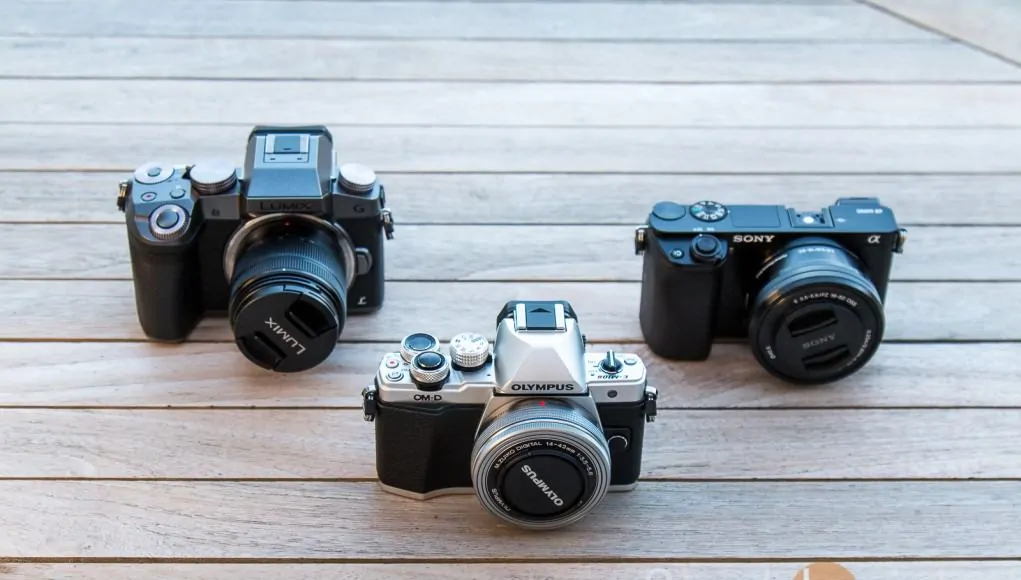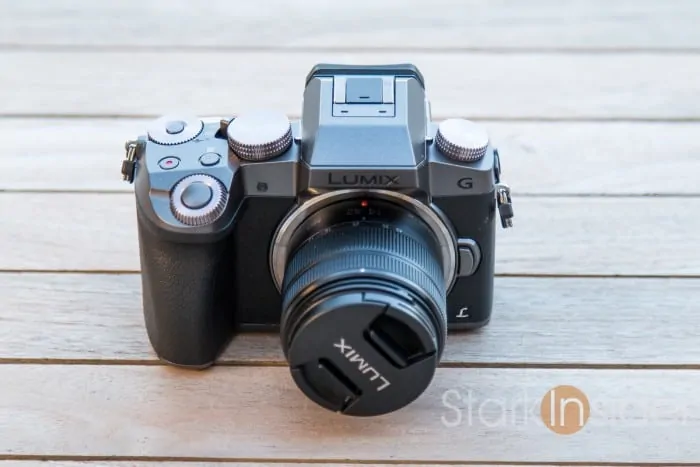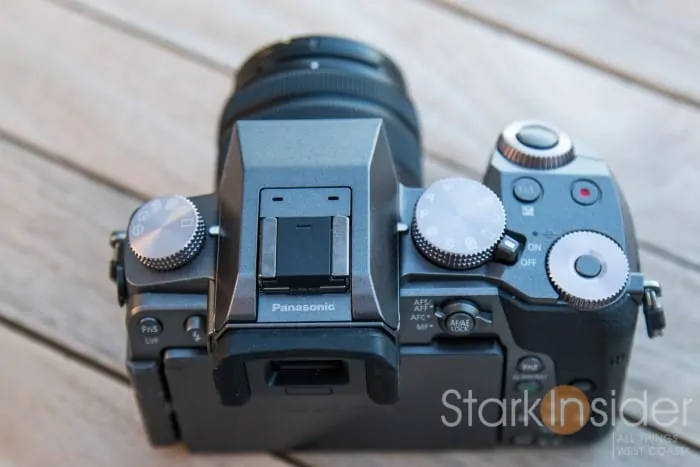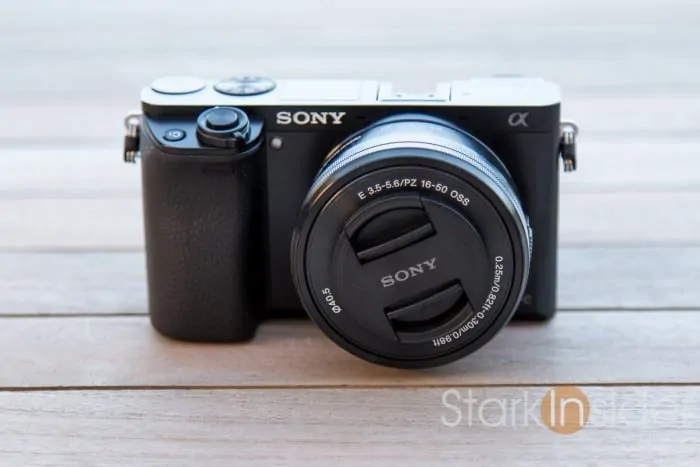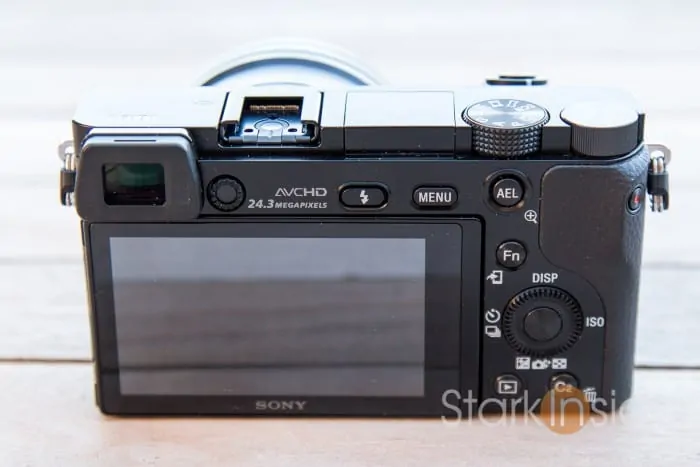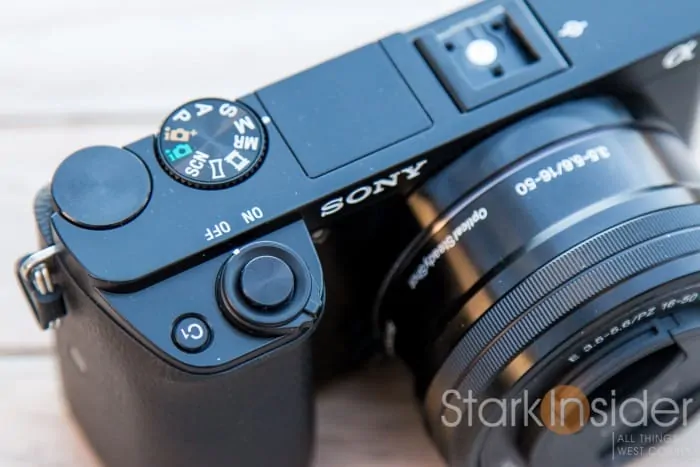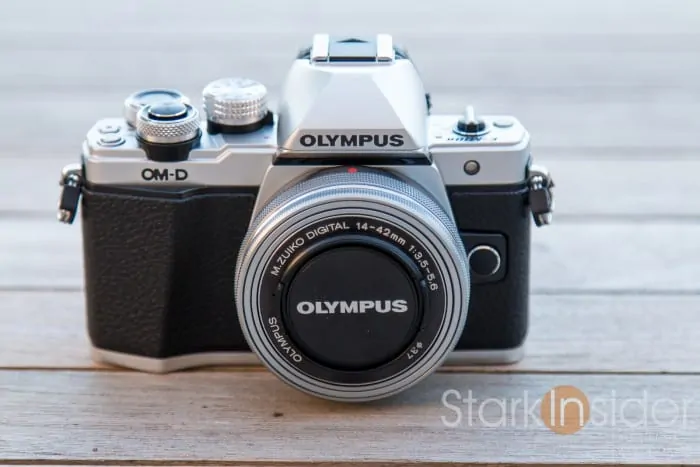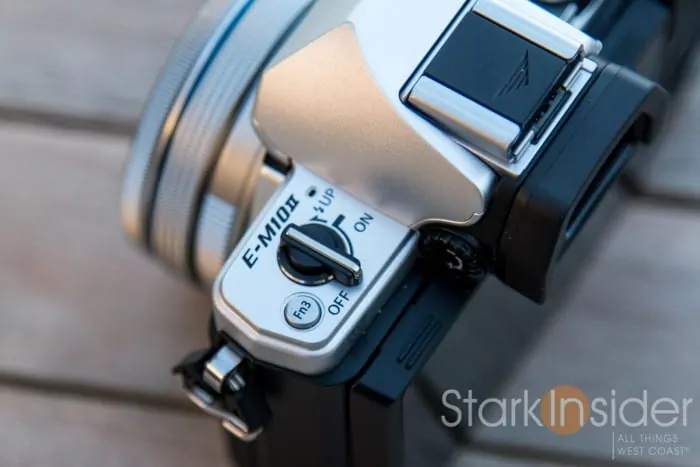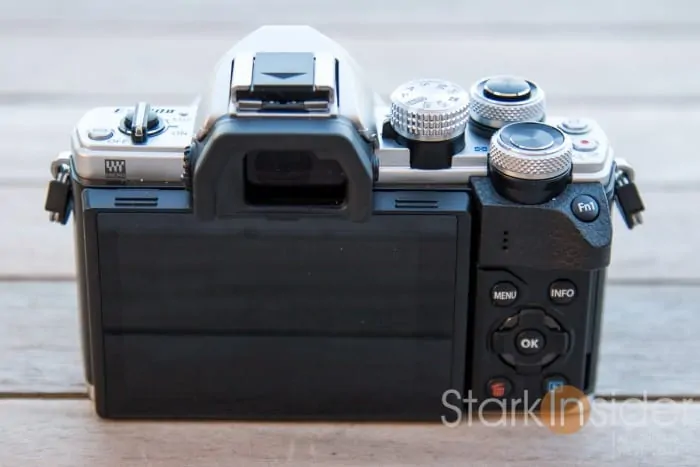Mirrorless cameras are the it thing in the world of photography (and videography too). Lightweight, and generally easy to use, these relatively small cameras are a dream come true for those that would rather not lug around boatloads of bulky old-school DSLR gear. In fact, after spending a few weeks testing several mirrorless models, when I picked up my (stellar) Canon EOS 70D it feel old-school indeed, like an aging dino — but one I still adore very much.
If you’re looking for a new mirrorless camera, maybe for travel and fun, or for more serious work like landscape or food photography, or maybe just to complement your existing gear, there’s plenty of good news. As I discovered during multiple shooting sessions, these cameras are the real deal. Do not let their toy like appearances deceive you:
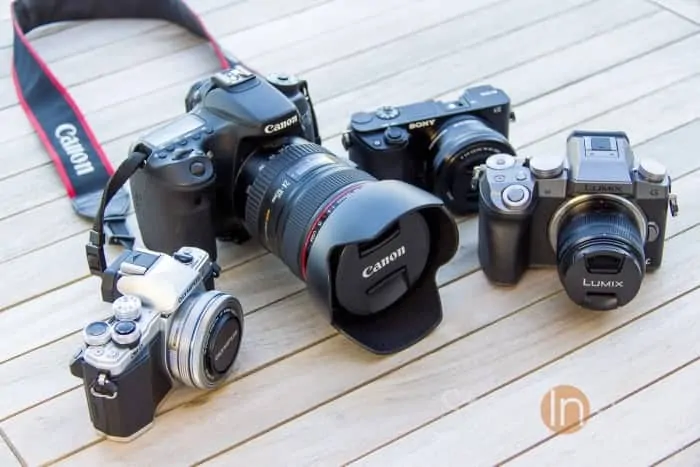
I’m quite certain that — with the right lens — at least one of these cameras could replace a far more expensive DSLR as a daily driver for serious work. More on that in a moment.
For this round-up we opted for a budget of around $600 (USD). One on this list is a little cheaper, one spot on, and the third a little pricier.
Since the DSLR revolution started in earnest with Canon’s introduction of the milestone 5D Mark II, I’ve been shooting video, and taking photos, on Canon bodies for Stark Insider (Vimeo). First with the venerable T2i, then the decent EOS 60D, before I embraced the dynamo known as the EOS 70D in all of its trick Dual-Pixel auto-focus glory in 2013. More recently I’ve been shooting video on a Canon C100 II cinema camera — that’s an entirely different story, a great one at that though as Canon’s cinema range is utterly amazing.
But when it comes to mirrorless, Canon is not really such a crowd pleaser. It seems the leaders here are brands like Panasonic, Olympus, Fujifilm, and Sony. Times they are a changing. Still, I’m not about to ditch my DSLRs quite yet — a nice compact walkaround camera that produces high quality images and has interchangeable lenses would be a welcome option!
So, you have about $550-700 to spend.
And you want a top notch mirrorless camera.
After spending almost a month with a batch of the best in that price range, these are the three that bubbled to the top. In no particular order…
Top 3: Best Mid-Range Mirrorless Cameras *
* but don’t ditch your DSLR quite yet
Panasonic Lumix G7
Best for: Video, those who want access to a variety of low-cost lens options, and value ease-of-use and a light weight body
Watch for: Plasticky-body, bigger than most mirrorless cameras, photo image not tops
Price: $599 with 14-42mm kit lens
Panasonic has done a really nice job with the G7. Released in 2015, the follow-on to the popular G6 ups the game in several areas, most notably video. 4K is the order of the day. You can burst photos in a special 4K mode (but at only 8MP vs. the standard 16MP) and then swipe through and choose your favorites to save. There’s 4K timelapse, and thanks to a firmware update you can now enable a feature called “Post Focus” which allows you to shoot a photo and then later choose the focal point. For example, you might want to choose the bride as the focal point in one, and the groom for another in the exact same photo. It works remarkably well.
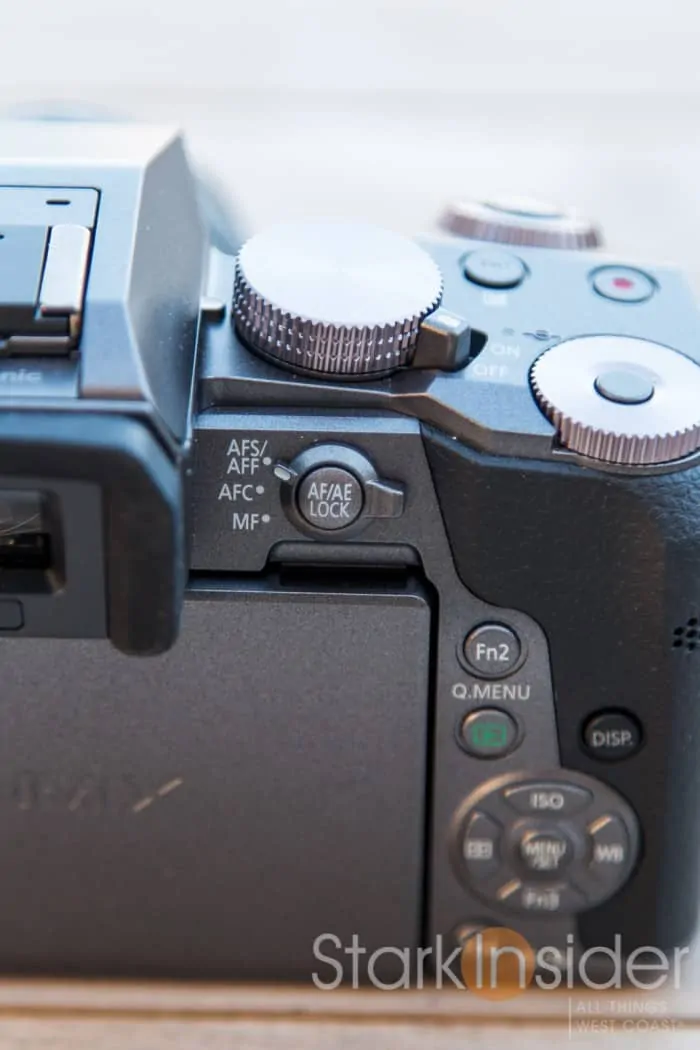
Ergonomics are top notch on the Panasonic Lumix G7. Twin dials on the right facilitate easy shutter and aperture adjustments, and the buttons rotate with a satisfying feel, and require no finger yoga to use. On the left, another dial, this one to choose various drive modes, including the aforementioned 4K burst mode, handy for fast action, sports, and other scenes that involve rapid moving objects; such as when trying to capture that perfect moment when a mother bird feeds its newborn a worm. Maybe?
Of the three cameras in this list, I most appreciated the Lumix G7 user interface and LCD screen. Everything is sharp, easy to read. And fast! The touchscreen is very responsive. Menus are well laid out (I never had to reference the manual) and using it is very satisfying. But there are two things to watch for…
Image quality. It’s very good. But, know, that at least in my testing, it’s not best in class. Close. Oh-so-close. Images, however, upon (intense) scrutiny don’t hold up to the Sony a6000 or Olympus E-M10 II, two others making this best-of roundup. It does require a certain amount of pixel peeping. I use Adobe Lightroom, and zoom in to look for artifacts, lack of detail, etc. No matter the mode — auto, P, A, S, M — the Sony and Olympus fared better when using the same settings.
Then there’s the build quality. It’s very plasticky. Surprisingly so. That makes for a light camera, and that’s nice. Operating the G7 definitely feels like handholding a toy. The results belie that feeling. Still, if you like a certain robustness in your gadgets and cameras — think iPhone — you’re not going to find that in the G7.
Overall, though I really like the Lumix G7.
I like that the kit lens is not powered. Instead, it’s an honest-to-goodness manual affair which I prefer. Given that the G7 shares the same sensor as its big brother GH4, video is the real calling card. If you want to get into filmmaking for under $1,000 I feel this would be a fabulous entry point. Any micro four thirds lenses you buy, could follow as you step up, say, to a GH4, or eventually, a GH5 — or even on an entry level cinema camera from Blackmagic.
Sony a6000
Best for: Image quality, taking shots of fast moving objects, landscape (thanks to its APS-C sensor and larger field of video)
Watch for: No touch screen, lacks silent mode (which can be found on the G7 and E-M10 II), could soon be replaced
Price: $549 with 14-42mm kit lens
Sensor. That’s the first thing to know about the Sony a6000. It has a seriously good sensor. In fact, it’s the same APS-C you’ll find in most mid-range DSLRs (such as the 70D). Bigger than the micro four thirds sensor found on the G7 and E-M10 II, this one will let in more light enabling better low-light photography (in theory at least), and provide a broader field of view (1.5x crop factor), which helps when wide angles are important (landscape photography).
Thanks to its generic looks and mundane point-and-shoot like styling, the a6000 won’t win any beauty contests anytime soon, but it gets the important stuff right. The grip feels good in the hand, the buttons and dials readily fall to the finger, and the shutter action is fast (you can burst up to 11fps).
Because there’s no touchscreen, you’ll need to rely on several buttons and, in particular, a dial on the back right to navigate menus and change settings. If you’re new to Sony, at first it can feel overwhelming. Give it a few days, and you’ll be right at home with the ergonomics.
Like the others, the a6000 features wi-fi so you can transfer photos to your smartphone (note that for some odd reason the Sony Play Memories app does not yet support Android 6.0 Marshmallow), and it has NFC as well. Bells and Whistles are not, however, this camera’s forte. Forget about in-camera stabilization, post focus options, or 4K video. Instead, you buy the a6000 for…
… image quality.
DXOmark rated the a6000 sensor at 82 points, handily besting the E-M10 II (73). There’s doesn’t yet appear to be a test of the G7. Given that it uses the same two-year old sensor as the Olympus I’d guess the results would be about the same.
Regardless of any ratings and other tests, I constantly found that for any given image, if I cropped my shots in Lightroom, and studied the pixels, the a6000 was reliably good. Yet not always best. I shoot handheld mostly, and that’s how I performed most of my tests. In several instances, and especially in low-light (throwing cold water onto the larger APS-C sensor is better in low light theory) the Olympus E-M10 II out-performed the a6000. Keep in mind, the sensor is well-rated, the 16-50mm kit lens is not. If you plan to buy this camera I’d expect that lens would be perfectly fine for travel, family events and running and gunning around town. For serious stuff though, and for things like large print reproductions, you’ll probably want to consider replacing the kit lens with something better.
However you look at it, for $549, the Sony a6000 is a raging bargain. It wouldn’t surprise me if this camera goes down in history with many of the greats… the Canon AE-1, T2i, 5D Mark II, Nikon D1, D90, Sony A7 series, Pentax K-3.
Olympus E-M10 II
Best for: Low light photography (the 5-axis image stabilization is superb), those who appreciate robust build quality,
Watch for: Dubious battery life, auto-EVF switching often happens when you don’t want it (for example, when your finger passes near the EVF while playing back photos on the LCD screen)
Price: $699 with 14-42mm kit lens
At the time of this writing, the Olympus E-M10 II is the most expensive of this trio ($699). What you get though is pedigree, and trickle down tech goodness. Many of the advanced features found on Olympus’ more expensive models have made their way down to to the second generation of this entry level camera. The headline for the Mark II is 5-axis stabilization (IBIS). Those who want to use non-stabilized lenses such as vintage glass, can now have at it, and enjoy the benefits of modern in-camera stabilization. Perhaps the Sony a7000 will have an answer in 2016, but for now Olympus seems to have the upper hand when it comes to helping photographers steady the image during slow shutter shots. In my testing it works exceptionally well. Low light photos with the a6000 were hit and miss, often with more noise in the details, whereas the E-M10 II would nail them.
Like the G7, this Olympus is designed as a twin dial shooter, with two dials sitting underneath your thumb and forefinger, making manual adjustments a breeze. Works extremely well, and is immediately intuitive.
Menus are not as easy to navigate. Though that has more to do with the vastness of the customization the E-M10 II offers, then it does with poor layout — there’s really only so many ways to layout a menu system with so many choices. Chances are any button or dial can be set exactly how you like. If that sound daunting, simply switch to “Auto” and shoot away, no doubt you’ll be happy as punch with the image quality.
Speaking of image quality. I was very impressed. This is where I take things like DXOmark ratings with a grain of salt. Surely, they put their cameras on tripods, under controlled lighting, and use various body/lens combinations which may, or may not, approximate your particular shooting style. For all three of these cameras I used the kit lenses solely, and shot handheld — because that’s how I, and I believe the majority of buyers will likely use these mid-range mirrorless cameras. Yes, there’s a science to evaluating quality of photos (and videos). Things like dynamic range, chromatic aberration, shadow retention, high ISO noise, can be measured. In the end, though, there’s also an art. If you look at something and it looks good, well then it looks good, and who can argue? Once again as I pixel peeped with Lightroom using identical settings (aperture, shutter, white balance, neutral profile, ISO) across all 3 of these cameras, the results were close, yet, clearly the a6000 and E-M10 II were a notch above the G7 in almost all scenarios. Once again, in low light, the 5-axis stabilization seemed to really help hold together the image, and retain sharpness, even up to 1600 ISO and long shutters (1/20 and 1/30). Pretty impressive for handheld work.
There are some things to be aware of with the E-M10 II:
— the battery charger has an extremely long, non travel-friendly power cord (fix: just buy a Wasabi or some other charger with a spare battery or two)
— when reviewing photos in playback, my finger would sometimes move too close to the EVF and the camera thinking it was my eye would switch off the LCD and turn on the EVF
— the fonts and overall aesthetics of the menus and icons are dated at best, and often hard to read at worst — the Lumix G7 is superior in this regard
— the E-M10 II was the first camera to die in each test, make sure you have spare batteries
— the grip: too shallow, and not as effective as the ones found on the a6000 and G7
Aside from these relatively minor gripes, I came away very impressed with the Olympus E-M10 II. I could easily see myself leaving the Canon 70D at home. And thanks to the micro four thirds sensor, lenses don’t cost an arm and a leg like the do for the e-Mount found on the Sony. Something definitely to consider.
Low Light Photo Gallery
Chardonnay



Spice Rack



Conclusion: Three Mirrorless Winners
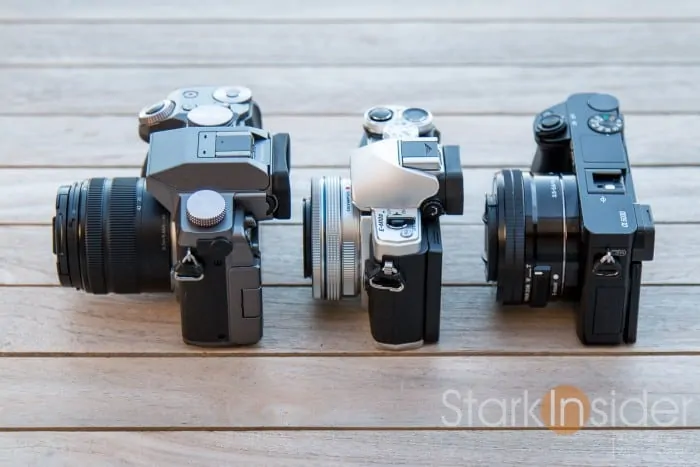
Mirrorless technology has come a long way in a short time, and these three cameras are superb examples of how much imaging power you can harness in such small packaging. I’m not quite ready to ditch my DSLR yet — my 70D could still outshoot all three of these (with their respective kit lenses) — but I feel mirrorless has shaken its past, and is no longer considered second fiddle (see: Sony A7 series… say no more).
It’s hard to go wrong with any of these cameras. Each are a joy to use, produce impressive image quality, and, importantly, are easy to toss into a bag, or purse.
My suggestion is to prioritize the type of shooting you’ll be doing and then consider which camera best meets those needs. To summarize I’d look at each of these three mirrorless cameras as follows:
Top 3: Clint’s Best Mid-Range Mirrorless Cameras
Best for video and ease of use:
Panasonic Lumix G7
Best for action shots, with the ability to turn into a DSLR replacement with the right lens:
Sony a6000
Best all-rounder and for handheld in low light:
Olympus E-M10 II
Friendly reminder, at the end of the day these are just tools. Framing, composition, experimenting/failing, lighting, being a little crazy… truly the things that will make the most difference.
Happy shooting!
Top 3: Clint’s Best Mid-Range Mirrorless Cameras
2. Sony a6000 $549 (probably the best bargain of the bunch)

